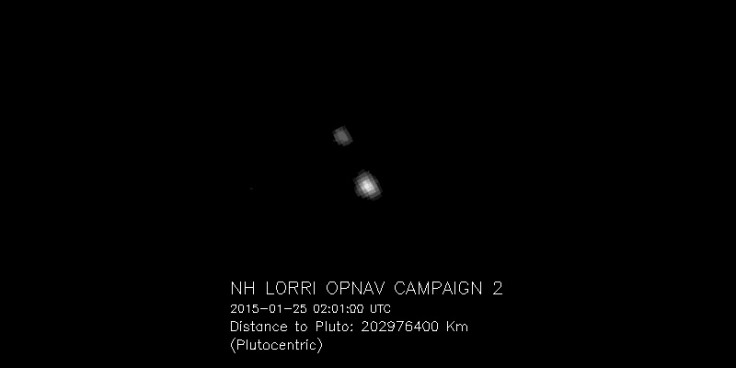Nasa's New Horizons probe beams back its first images of Pluto

Nasa's New Horizons space probe returned its first images of Pluto on Wednesday (4 February), as the probe makes its closest approach to the planet.
The photos, which show Pluto and its largest moon Charon, were taken by the New Horizon's telescopic Long-Range Reconnaissance Imager (LORRI) on 25 Jan and 27 Jan when New Horizons was more than 126 million miles (203 million km) away from Pluto.
They have been released in honour of Pluto discoverer Clyde Tombaugh's 109<sup>th birthday.
They are the first photos to have been acquired during the spacecraft's 2015 approach to the Pluto system, which culminates with a close flyby of Pluto and its moons on 14 July.
"This is our birthday tribute to Professor Tombaugh and the Tombaugh family, in honour of his discovery and life achievements — which truly became a harbinger of 21st century planetary astronomy," said New Horizons principal investigator Alan Stern, from the Southwest Research Institute in Boulder, Colorado.
"These images of Pluto, clearly brighter and closer than those New Horizons took last July from twice as far away, represent our first steps at turning the pinpoint of light Clyde saw in the telescopes at Lowell Observatory 85 years ago, into a planet before the eyes of the world this summer."
As the New Horizons probe gets closer to Pluto, the dwarf planet will become larger and larger in the hundreds of pictures that New Horizon's LORRI will take.
Of course, the images will continue to resemble little more than bright dots in the camera until almost summer, but the mission navigators can still use the images to design course-directing engine manoeuvres to angle the space probe for a more precise approach.
"Pluto is finally becoming more than just a pinpoint of light," said Hal Weaver, New Horizons project scientist at the Johns Hopkins University Applied Physics Laboratory in Laurel, Maryland.
"LORRI has now resolved Pluto, and the dwarf planet will continue to grow larger and larger in the images as New Horizons spacecraft hurtles toward its targets.
"The new LORRI images also demonstrate that the camera's performance is unchanged since it was launched more than nine years ago."
The New Horizons probe was launched on 19 January 2006 and has already covered over three billion miles since it was launched.
Its journey has so far taken it past each planet's orbit, from Mars to Neptune, and its close encounter with Pluto is meant to provide not just long-distance imaging, but also dust, energetic particle and solar wind measurements to characterise the space environment near Pluto.
© Copyright IBTimes 2025. All rights reserved.






















